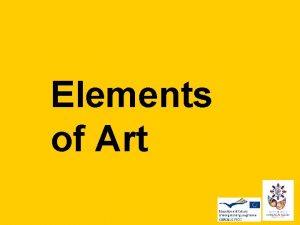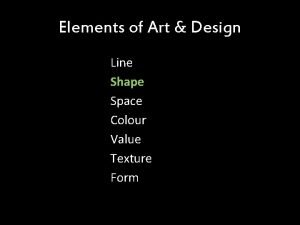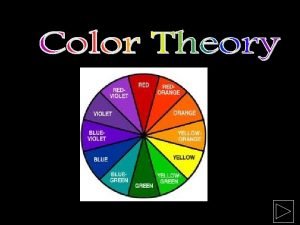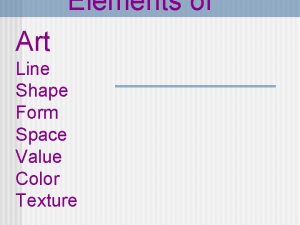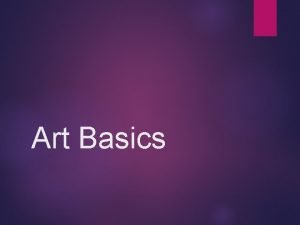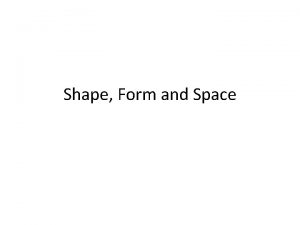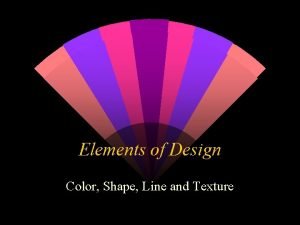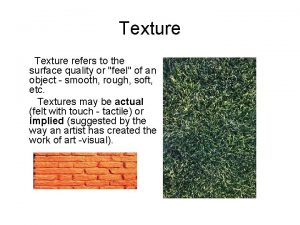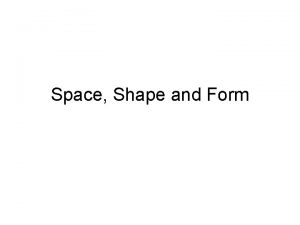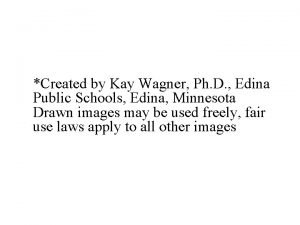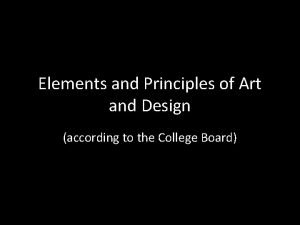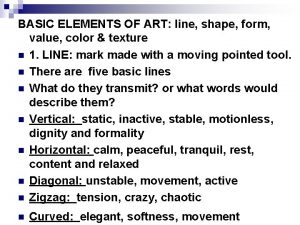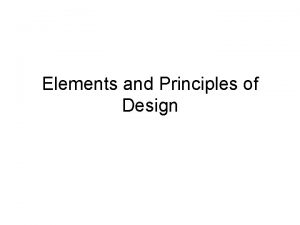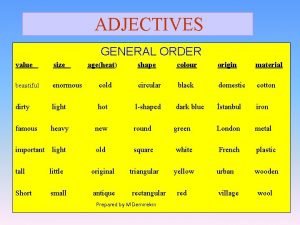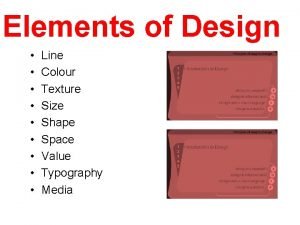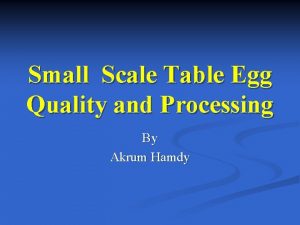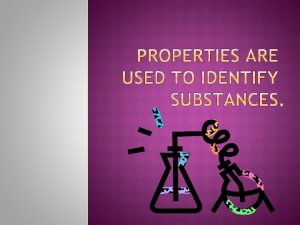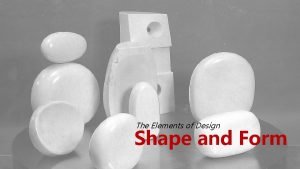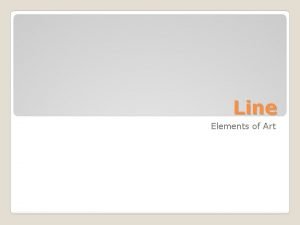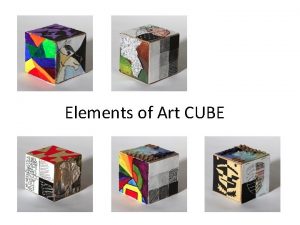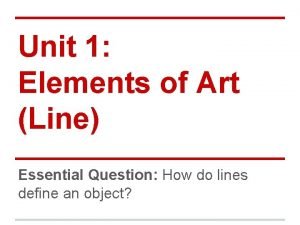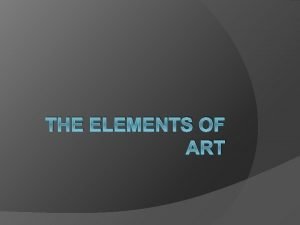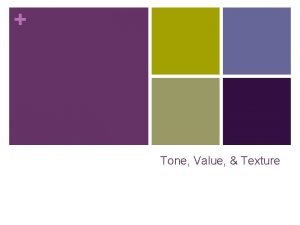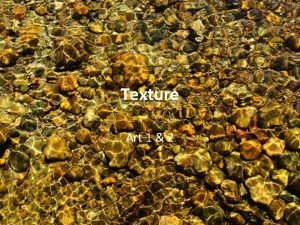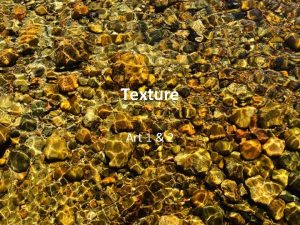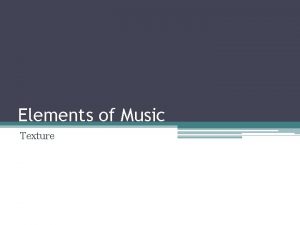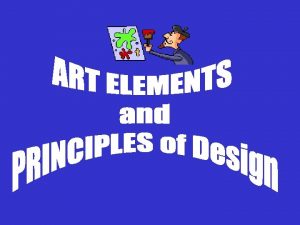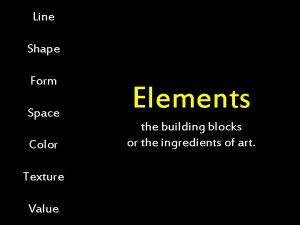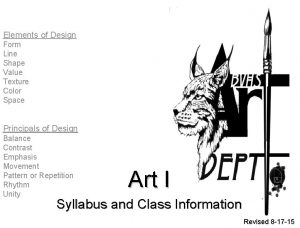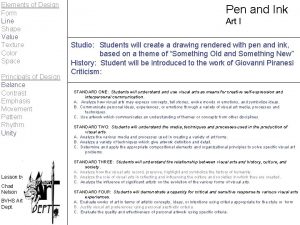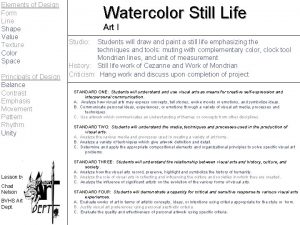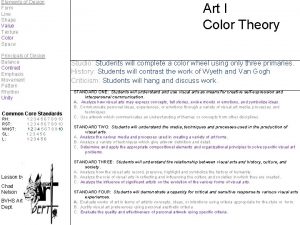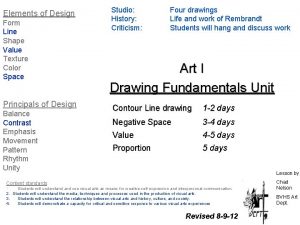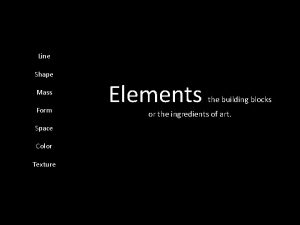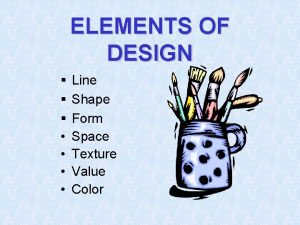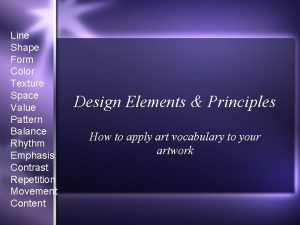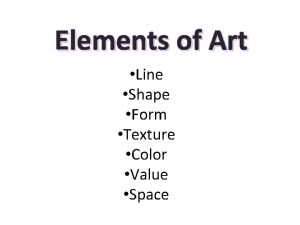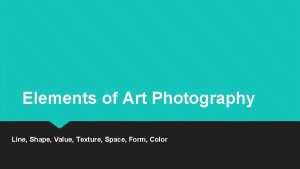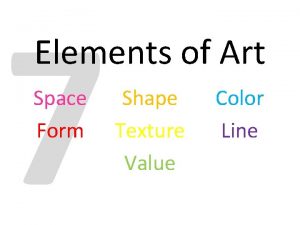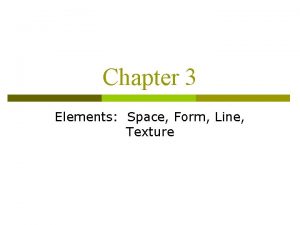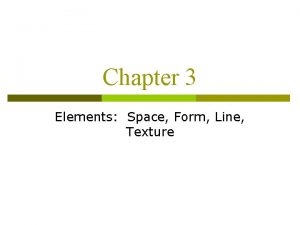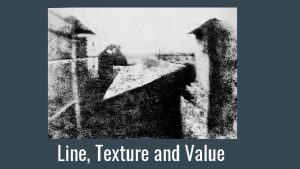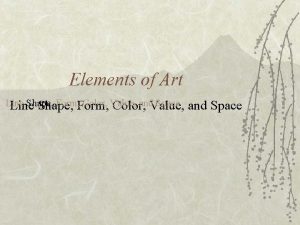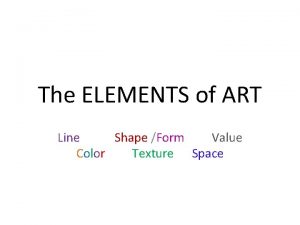ART ELEMENTS Line Shape Space Form Value Texture






























- Slides: 30

ART ELEMENTS ● Line ● Shape ● Space ● Form ● Value Texture ● ● Color

WHAT ARE ART ELEMENTS? ? Art Elements make up nearly everything found in a piece of Art. ● A piece of Artwork can have 1, 2 or even ALL 7 of the Art Elements. ● Art Elements are the basic fundamentals of ART. ●

LINE ● A dot that went for a walk. ● LINE can be shown in a variety of ways.

LINE Line can be found in almost every drawing and painting. ● CAN YOU IDENTIFY LINE IN THIS DRAWING? ? ? ●

LINE ● HOW ABOUT THIS PAINTING. . . ● CAN YOU IDENTIFY LINE? ? ?

LINE ● EVEN THIS PAINTING? ? ?

SHAPE ● An area enclosed by line. ● Nearly all artwork has some sort of SHAPE. Shapes come in all sizes and vary in each individual artwork. ●

SHAPE Shapes can also be found in the majority of artwork. Especially in 3 -Dimensional Art. ●

SHAPE ● Can you find the shapes in this Painting?

SHAPE ● How about this drawing?

VALUE ● The lightness or darkness of a surface. ● Value can often mean the tint or tone of a color. Value can be added to 2 -dimensional objects to make them 3 -dimensional. ● The amount of light that hits a surface, often times effects the VALUE. ●

Value Scale A range of values that transition from dark to light. ●

Gradation ● Gradation scale- is a transition from dark to light.

Gradation ● Gradation scale- is a transition from dark to light.

VALUE HOW DOES THIS ARTIST USE VALUE? ?

TINT vs SHADE Tints and shades are often added during a painting. ● Tints- are typically added to show light hitting a surface. ● ● Shades- are typically added to show shadows.

FORM ● 3 -Dimensional OR occupying space. ● Often times has value and/or casts a shadow.

Form can be found in the majority of Sculptures, ceramics, architecture or any other 3 -dimensional artwork. ●

FORM Form can also be found in 2 -Dimensional artwork, such as drawings, painting, printmaking or photography. ●

SPACE The illusion of objects having depth on a 2 dimension surface. ● ● Space is often shown by: –Overlapping –Changing –Having objects the size of objects a foreground, middle ground and

SPACE How does this artist create the illusion of space within this painting. ●

SPACE Space can also be shown in other 2 dimensional artwork such as photography, printmaking, drawing or etching. ●

SPACE How does the artist show space within this painting? ●

TEXTURE Texture is the implied feeling on a 2 dimensional surface. ● Texture recommends that an object has a certain feel to it. ●

TEXTURE ● Crayon rubbing. . .

COLOR ● The amount of light reflecting off of a surface. ● ROY-G-BIV ● There are many categories of color such as: –Primary, Secondary, Complimentary, Analogous, Tertiary, warm, cool etc.

COLOR WHEEL

COLOR While painting, color can be manipulated and altered by mixing 2 or more colors. ● Mixing 2 primary colors will give us a secondary color. ● Color can be used in nearly all areas of ART including: ● –Drawing, painting, glazing, sculpting, architecture, photography etc.

COLOR How does this artist use color within his painting? ●

COLOR How does Van Gogh choose to use color within his artwork? ●
 Line value shape form space texture and color
Line value shape form space texture and color Shape space art
Shape space art Form shape and space
Form shape and space Line shape and form
Line shape and form Elements and principles of design matrix examples
Elements and principles of design matrix examples Form shape and space
Form shape and space Shape color texture
Shape color texture The tactile quality of a surface
The tactile quality of a surface Small areas of white used to show the very brightest spots
Small areas of white used to show the very brightest spots Apa itu value creation
Apa itu value creation Elements of art space
Elements of art space Color line
Color line Elements of art space
Elements of art space A feeling of visual equality in shape form value color etc
A feeling of visual equality in shape form value color etc The basic element of art
The basic element of art The feeling of harmony between all parts of the artwork
The feeling of harmony between all parts of the artwork Size shape age color
Size shape age color Size shape color texture
Size shape color texture Firmness of the yolk and freedom from yolk defects
Firmness of the yolk and freedom from yolk defects Egg parts diagram
Egg parts diagram Color shape and texture are what properties
Color shape and texture are what properties Element of design shape and form
Element of design shape and form Line element of art
Line element of art Element of art cube
Element of art cube Descriptive lines art
Descriptive lines art Art elements line
Art elements line Value/tone
Value/tone Actual texture
Actual texture Simulated texture in art
Simulated texture in art What is representative fraction
What is representative fraction Sandwich elements of music
Sandwich elements of music
